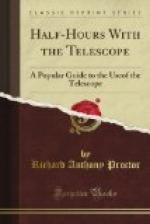A telescope should not be mounted within doors, if it can be conveniently erected on solid ground, as every movement in the house will cause the instrument to vibrate unpleasantly. Further, if the telescope is placed in a warm room, currents of cold air from without will render observed objects hazy and indistinct. In fact, Sir W. Herschel considered that a telescope should not even be erected near a house or elevation of any kind round which currents of air are likely to be produced. If a telescope is used in a room, the temperature of the room should be made as nearly equal as possible to that of the outer air.
When a telescope is used out of doors a ‘dew-cap,’ that is, a tube of tin or pasteboard, some ten or twelve inches long, should be placed on the end of the instrument, so as to project beyond the object-glass. For glass is a good radiator of heat, so that dew falls heavily upon it, unless the radiation is in some way checked. The dew-cap does this effectually. It should be blackened within, especially if made of metal. “After use,” says old Kitchener, “the telescope should be kept in a warm place long enough for any moisture on the object-glass to evaporate.” If damp gets between the glasses it produces a fog (which opticians call a sweat) or even a seaweed-like vegetation, by which a valuable glass may be completely ruined.
The observer should not leave to the precious hours of the night the study of the bearing and position of the objects he proposes to examine. This should be done by day—an arrangement which has a twofold advantage,—the time available for observation is lengthened, and the eyes are spared sudden changes from darkness to light, and vice versa. Besides, the eye is ill-fitted to examine difficult objects, after searching by candle-light amongst the minute details recorded in maps or globes. Of the effect of rest to the eye we have an instance in Sir J. Herschel’s rediscovery of the satellites of Uranus, which he effected after keeping his eyes in darkness for a quarter of an hour. Kitchener, indeed, goes so far as to recommend (with a crede experto) an interval of sleep in the darkness of the observing-room before commencing operations. I have never tried the experiment, but I should expect it to have a bad rather than a good effect on the eyesight, as one commonly sees the eyes of a person who has been sleeping in his day-clothes look heavy and bloodshot.
The object or the part of an object to be observed should be brought as nearly as possible to the centre of the field of view. When there is no apparatus for keeping the telescope pointed upon an object, the best plan is so to direct the telescope by means of the finder, that the object shall be just out of the field of view, and be brought (by the earth’s motion) across the centre of the field. Thus the vibrations which always follow the adjustment of the tube will have subsided before the object appears. The object should then be intently watched during the whole interval of its passage across the field of view.




